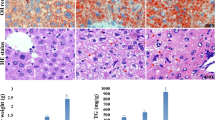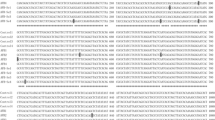Abstract
The effect of aflatoxin B1 (AFB1) on the expression of glutathione S-transferase-P (GST-P) which is the major isoform of GST in developmental stages has been investigated in rat liver during prenatal and postnatal stages. Following administration of AFB1 (0, 0.5, 1.0, 2.0, 3.0 or 4.0 mg/kg bw) injected I.P on day 8.5 of gestation the number of dead or reabsorbed fetuses and malformed embryos were recorded. Then the fetal livers were processed for measurement of total GST and GST-P activities, using 1-chloro-2,4-dinitrobenzene (CDNB) and ethacrynic acid (ETA) as substrates respectively. RT-PCR using rat GST-P specific primers was performed on mRNA extracted from livers. Besides, the effects of AFB1 on hepatic GST and GST-P were assessed in groups of suckling rats directly injected with the toxin. The results show that a single dose of AFB1 (1.0 or 2.0 mg/kg bw) caused approximately 50–60% depletion in fetal liver GST towards CDNB. Postnatal experiments revealed that liver GST (using CDNB as substrate) was significantly induced (~40%) in suckling rats injected with a single dose of AFB1 (3.0 mg AFB1/kg) 24 h before killing. Liver GST-P expression was unaffected due to AFB1 exposures of rats before and after the birth. This finding was substantiated by western blotting and RT-PCR techniques. These data suggest that AFB1-related induction in rat liver total GST after birth may be implicated in protective mechanisms against AFB1. In contrast, inhibition of this enzyme in fetal liver following placental transfer of the carcinogen may explain high susceptibility of fetal cells to transplancental aflatoxins. Furthermore, lack of influence of AFB1 on GST-P expression in developmental stages can role out the involvement of this class of GST in AFB1 biotransformation.









Similar content being viewed by others
References
Allameh A, Farahani M, Zarghi A (2000) Kinetic studies of aflatoxin B1-glutathione conjugate formation in liver and kidneys of adult and weaning rats. Mech Aging Dev 115:73–83
Allameh A, Saxena M, Raj HG (1987) Differential effects of butylated hydroxyanisole on metabolism of aflatoxin B1 in vitro by liver and lung microsomes. Cancer Lett 40:49–57
Allameh A, Vansoun EY, Zarghi A (1997) Role of glutathione conjugation in protection of weanling rat liver against acetaminophen-induced hepatotxicity. Mech Aging Dev 95:71–79
Autrup H (1993) Transplacental transfer of genotoxins and transplancental carcinogenesis. Environ Health Perspect 101:33–38
Bradford MM (1976) A rapid and sensitive method for the quantitation of microgram quantities of protein utilizing the principle of protein-dye binding. Anal Biochem 72:248–254
Buetler TM, Eaton DL (1992) cDNA cloning, mRNA expression of alpha-class glutathione S-transferases in mouse tissues. Cancer Res 52:314–318
Chelcheleh M, Allameh A (1995) In vivo biotrasformation of aflatoxin B1 and its interaction with cellular macromolecules in neonatal rats. Mech Aging Dev 78:189–196
Coles B, Meyer DJ, Ketterer B, Stanton CA, Garner RC (1985) Studies on the detoxication of microsomally-activated aflatoxin B1 by glutathione and glutathione transferases in vitro. Carcinogenesis 6:693–697
Degen GH, Neumann HG (1978) The major metabolite of aflatoxin B1 in the rat is a glutathione conjugate. Chem Biol Interact 22:239–255
Degen GH, Neumann HG (1981) Differences in aflatoxin B1-susceptibility of rat and mouse are correlated with the capability in vitro to inactivate aflatoxin B1-epoxide. Carcinogenesis 2:299–306
Denning DW, Allen R, Wilkinson AP, Morgan MR (1990) Transplacental transfer of aflatoxin in humans. Carcinogenesis 11:1033–1035
Dix KM (1984) The development of hepatocellular tumours following aflatoxin B1 exposure of the partially hepatectomised mouse. Carcinogenesis 5:385–390
Elis J, DiPaolo JA (1967) Aflatoxin B1, induction of malformations. Arch Pathol 83:53–57
Essigman JM, Croy RG, Bennet RA, Wogan GN (1982) Metabolic activation of aflatoxin B1: pattern of DNA adduct formation, removal and excretion in relation to carcinogenesis. Drug Metab Rev 13:581–602
Grice HC, Moodie CA, Smith DC (1973) The carcinogenic potential of aflatoxin or its metabolites in rat from dams fed aflatoxin pre and postpartum. Cancer Res 33:262–268
Goertller K, Lohrke H, Schweizer HJ (1980) Effects of aflatoxin B1 on pregnant inbred Sprague–Dawley rats and their F1 generation: A contribution to transplancental carcinogenesis. J Natl Cancer Inst 64:1349–1354
Groopman JD, Cain LG, Kensler TW (1986) Aflatoxin exposure in human populations: measurements and relationship to cancer. Crit Rev Toxicol 19:113–145
Gallagher EP, Gardner JL (1992) Comparative expression of two alpha class glutathione S-transferases in human adult and prenatal liver tissues. Biochem Pharmacol 63:1921–2074
Habig WH, Pabst MJ, Jakoby WB (1974) Glutathione S-transferases: the first enzymatic step in mercapturic acid formation. J Biol Chem 25:7130–7139
Hayes JD, Flangan JU, Jowsey IR (2005) Glutathione transferases. Annu Rev Pharmacol 45:51–88
Hayes JD, Judah DJ, Neal GE, Nguyen T (1992) Molecular cloning and heterologous expression of a cDNA encoding a mouse glutathione S-transferase Yc subunit possessing high catalytic activity for aflatoxin B1–8, 9-epoxide. Biochem J 285:173–180
Hayes JD, Nguyen T, Judah DJ, Petersson DG, Neal GE (1994) Cloning of cDNAs from fetal rat liver encoding glutathione S-transferase Yc polypeptides The Yc2 subunit is expressed in adult rat liver resistant to the hepatocarcinogen aflatoxin B1. Biol Chem 269:20707–207017
Herrold KM (1969) Aflatoxin induced lesions in syrian hamsters. Br J Cancer 21:655–660
Jhee EC, Ho LL, Lotlikar PD (1988) Effect of butylated hydroxyanisole pretreatment on in vitro hepatic aflatoxin B1-DNA binding and aflatoxin B1-glutathione conjugation in rats. Cancer Res 48:2688–2692
Juchau MR., Lee QP, Fantel AG (1992) Xenobiotic biotransformation/ bioactivation in organogenesis-stage conceptal tissues: Implications from embryotoxicity and teratogenesis. Drug Metab Rev 24:195–238
Kitada M, Kamataki T (1994) Cytochrome P450 in human fetal liver: Significance and fetal-specific expression. Drug Metab Rev 26:305–323
Knapen MFCM, Peters WHM, Mulder TPJ (1999) Glutathione and glutathione-related enzymes in decidua and placenta of controls and women with pre-eclampsia. Placenta 20:541–546
Krauer B, Dayer P (1991) Fetal drug metabolism and its possible clinical implications. Clin Pharmacokinet 21:70–80
Lotlikar PD, Jhee EC, Insetta SM, Clearfield MS (1984) Modulation of microsome-mediated aflatoxin B1 binding to exogenous and endogenous DNA by cytosolic glutathione S-transferases in rat and hamster livers. Carcinogenesis 5:269–276
Monroe DH, Eaton DL (1987) Comparative effects of butylated hydroxyanisole on hepatic in vivo DNA binding and in vitro biotransformation of aflatoxin B1 in the rat and mouse. Toxicol Appl Pharm 90:401–409
Moore MR, Pitot HC, Miller EC, Miller JA (1982) Cholangio-cellular carcinomas induced in syrian golden hamsters administered aflatoxin B1 in large doses. J Natl Cancer Inst 68:271–278
Neal GE, Judah DJ, Stripe F, Patterson DSP (1981) The formation of 2,3-dihydroxy-2,3-dihydro-aflatoxin B1 by the metabolism of aflatoxin B1 by liver microsomes isolated from certain avian and mammalian species and the possible role of the metabolite in the acute toxicity of aflatoxin B1. Toxicol Appl Pharmacol 58:431–437
Neal GE, Nielsch U, Judah DJ, Hulbert PB (1987) Conjugation of model substrates or microsomally-activated aflatoxin B1 with reduced glutathione, catalysed by cytosolic glutathione S-transferases in livers of rats, mice and guinea pigs. Biochem Pharmacol 36:4269–4276
Newberne PM, Butler WM (1969) Acute and chronic effects of aflatoxin on the liver of domestic and laboratory animals: a review. Cancer Res 29:236–250
O’ Brien K, Moss E, Judah D, Neal G (1983) Metabolic basis of the species difference to aflatoxin B1 induced hepatotoxicity. Biochem Biophys Res Commun 114:813–821
Raijmakers MTM, Steegers EAP, Peters WHM (2001) Glutathione S-transferases and thiol concentration in embryonic and early fetal tissues. Hum Reprod 16:2445–2450
Raj HG, Clearfield MS, Lotlikar PD (1984) Comparative kinetic studies on aflatoxin B1-DNA binding and aflatoxinB1-glutathione conjugation with rat and hamster livers in vitro. Carcinogenesis 2:299–306
Raj HG, Prasanna HR, Magee PN, Lotlikar PD (1986) Effect of purified rat and hamster hepatic glutathione S-transferases on the microsome mediated binding of aflatoxin B1 to DNA. Cancer Lett 33:1–9
Ramsdell HS, Eaton DL (1990) Species susceptibility to aflatoxin B1 carcinogenesis: comparative kinetics of microsomal biotransformation. Cancer Res 50:615–620
Raney KD, Meyer DJ, Ketterer B, Harris TM, Guengerich FP (1992) Glutathione conjugation of aflatoxin B1 exo-and endo-epoxides by rat and human glutathione S-transferases. Chem Res Toxicol 5:470–478
Ronzoni S, Marconi AM, Cetin I, Paolini CL, Teng C, Pardi G (1999) Umbilical amino acid uptake at increasing maternal amino acid concentrations: effect of a maternal amino acid infusate. Am J Obstet Gynecol 181:477–483
Steisslinger HW, Pfleiderer G (1988) Acidic and basic forms of glutathione S-transferases from human placenta and comparison with human kidney glutathione S-transferase. Enzyme 40:1–6
Strange RC, Jones PW, Fryer AA (2000) Glutathione S-transferase: genetics and role in toxicology. Toxicol Lett 112:357–363
Shupe T, Sell S (2004) Low hepatic glutathione S-transferase and increased hepatic DNA adduction contribute to increased tumorigenicity of aflatoxin B1 in newborn and partially hepatectomized mice. Toxicol Lett 148:1–9
Swenson DH, Lin J, Miller EC, Miller JA (1977) Aflatoxin B1-2,3-oxide as a probable intermediate in the covalent binding of aflatoxin B1 and B2 to rat liver DNA and ribosomal RNA in vivo. Cancer Res 37:172–181
Towbin H, Staehelin T, Gordon J (1979) Electrophoretic transfer of proteins from polyacrylamide gels to nitrocellulose sheets: Procedure and some applications. Proc Natl Acad Sci USA 76:4350–4354
Wells PG, Winn LM (1996) Biochemical toxicology of chemical teratogenesis. Crit Rev Biochem Mol Biol 31:1–40
Wild CP, Shrestha SM, Anwar WA, Montesano R (1992) Field studies of aflatoxin exposure, metabolism, and induction of genetic alterations in relation to HBV infection and hepatocellular carcinoma in the Gambia and Thailand. Toxicol Lett 64–65:455–461
Zuslerzeel PL, Peters WH, De Bruyn MA (1999) Glutathione S-transferase isoenzymes in deciduas and placenta of pre-eclamptic pregnancies. Obstet Gynecol 94:1033–1038
Author information
Authors and Affiliations
Corresponding author
Rights and permissions
About this article
Cite this article
Fatemi, F., Allameh, A., Dadkhah, A. et al. Changes in hepatic cytosolic glutathione S-transferase activity and expression of its class-P during prenatal and postnatal period in rats treated with aflatoxin B1. Arch Toxicol 80, 572–579 (2006). https://doi.org/10.1007/s00204-006-0076-2
Received:
Accepted:
Published:
Issue Date:
DOI: https://doi.org/10.1007/s00204-006-0076-2




